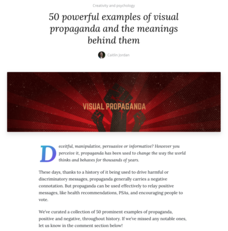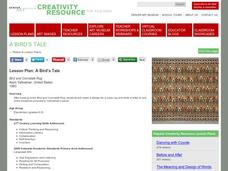Canva
50 Powerful Examples of Visual Propaganda and the Meanings Behind Them
Propagandists have many tools at their disposal to influence thinking and behavior. Among the most powerful are the visual tools, posters designed to grab the attention and stir the emotions of viewers. Check out this collection of...
Curated OER
Identifying Patterns
What's the pattern? Youngsters examine four sets of sequential images to detect a pattern and continue it onto a fourth image. Ask them to verbalize what they noticed and how they continued this pattern. Consider extending the concept...
Curated OER
Seeing the Image in Imagery: A Lesson Plan Using Film
In our increasingly visual society, it is often difficult for some readers to create a mental picture of a picture created only with words. An image-rich text like F. Scott Fitzgerald's The Great Gatsby can therefore, present a real...
Curated OER
Expanded Images
Allow your young artists to use their imagination with this fun art project! Cut out various images from a magazine to be the spark to your artists' creativity. Have them glue an image onto a piece of paper, then draw a backdrop to go...
Curated OER
Portraits, Pears, And Perfect Landscapes: Investigating Genre in the Visual Arts
Differentiate between the various genres in the visual arts world, particularly in Western painting. Your class can view and discuss, in small groups, paintings published on the National Galleries website. Then each student individually...
Maryland Department of Education
The Concept of Identity Lesson 8: Propaganda in Visual Media
Visual and print propaganda are featured in a lesson that asks readers of A Separate Peace to examine the techniques used in propaganda from World War I, World War II, presidential elections, and in the novel.
Film Foundation
To Kill a Mockingbird: What Is a Movie?
The challenge film makers face when creating a film based on a novel or nonfiction text is the focus of a interdisciplinary resource that uses To Kill a Mockingbird to teach viewers how to read the visual images of film. A must-have...
Curated OER
Basic Visual Language Ii: How To Analyze a Visual Text
Students identify techniques used to communicate visually. They compare and contrast different visual techniques found in mass media. They apply their understanding by creating photographs that use a variety of visual literacy techniques.
Curated OER
Animal Self-portrait Mosaics: A Visual Arts Elective
Out-lined here is a two-week procedure that has the class creating ceramic animal tiles that are metaphorical representations of their own personalities. They discuss animal images found throughout history, what they mean, metaphor, and...
Curated OER
Follow the Leader: Line in the Visual Arts
Students explore line in painting and drawing and examine how it is defined in the visual arts. Recognizing line in the composition of a number of art works and how it affects these works of art is the focus of this lesson.
Curated OER
An Introduction to the Relationship Between Composition and Content in the Visual Arts
Young scholars investigate how artists create a story that provides a message or provokes emotions in a single image. The ways in which the composition of a painting contributes to telling the story or conveying the message is examined...
Curated OER
Help the Upset Person Activity
Assess what self-help techniques your students know for dealing with upset emotions with this conversational activity. The teacher begins by role playing as an upset individual, using visual images as prompts, and then asks students for...
Mr. Hill's Science Website
Identifying Phases of the Moon
Is that a waxing crescent or waning gibbous moon? Here's a comprehensive set of worksheets complete with great visuals that will have your kids spouting off the lunar cycle in order!
National Gallery of Canada
Mastering One-Point Perspective
Cover one-point perspective through observation and practice. Class members examine several works of art that use one-point perspective, look at magazine images to find the vanishing points and horizon lines, and draw their own city...
Curated OER
Lesson Plan: A Bird's Tale
Who wouldn't love to get a letter from a blue bird? Elementary art enthusiasts analyze the social and historical context of Ason Yellowhair's Navajo piece, Bird and Cornstalk Rug. They examine the construction and images on the rug...
Digital Forsyth
Photo Analysis for Visual Impact
A lesson on photo analysis, compare and contrast, and an art project are here for the taking. Fourth graders analyze photographs of gas stations from now and from the past, focusing on how the cars and building designs are a form of art....
Cornell University
Constructing and Visualizing Topographic Profiles
Militaries throughout history have used topography information to plan strategies, yet many pupils today don't understand it. Scholars use Legos and a contour gauge to understand how to construct and visualize topographic profiles. This...
New Class Museum
Lesson: Emory Douglas: Decoding Images and Vocabulary Activity
To better understand the work of Black Panther logo artist Emory Douglas, learners define literary devices. They define a series of words such as metaphor, simile, and assonance, then place an example of that device found in Emory...
Curated OER
Lesson: Double Album: The Collection and the Archive
An open discussion starts this lesson off. The class takes a critical look at five works of art that demonstrate the impact and purpose of identity through collections or archives. They then write a list or draw 10-15 items found in...
Curated OER
Rhyming Words: Ball and Wall
Preschoolers and kindergartners can identify the pictures that do not rhyme with the lead image. They say each of the four words and then find the image that doesn't belong. In addition, they trace the words ball and wall.
Curated OER
Match the Pictures
Which of these objects are the same? Get your pre-readers comfortable with identifying objects that are identical, focusing on the term same. They examine eight pictures, drawing a line between those that are the same. The objects should...
Curated OER
Odd Ones Out
Some of these words don't rhyme; scholars determine which ones as they examine four sets of images with the vowel sound /e/. For each set, they circle the words that don't rhyme with the first image. Be sure kids know what these images...
Curated OER
Lesson: Elizabeth Peyton: The Self in the Other's Image: Portraiture and Identity
Art, identity, and an imaginary community, three components that should make for an interesting lesson. Critical thinkers explore and evaluate the work of contemporary artist, Elizabeth Peyton. They discuss her use of subject and art to...
Curated OER
Molly Pitcher -- "Out of Many, One"
Students research, brainstorm and analyze the events that lead up to the Revolutionary War. They critique a piece of artwork depicting a scene from the Revolutionary War. Each major battle is plotted on a map to show a visual...

























